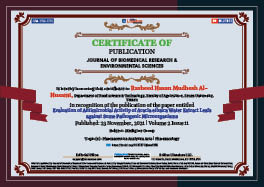Abdulmageed B Abdullah, Abdulbaki Al-zaemey, Rasheed Hasan Mudhesh Al-Husami* and Mofeed Al-Nowihi
Volume2-Issue11
Dates: Received: 2021-11-03 | Accepted: 2021-11-20 | Published: 2021-11-23
Pages: 1132-1135
Abstract
The antimicrobial activity about water extract of Acacia etbaica was examined by using agar well diffusion methods against five gram-positive and negative bacteria[Staphylococcus aureus (ATCC653-8), Pseudomonas aeruginosa MTCC2453, Bacillus cereus (ATCC6633), Escherichia coli MTCC739, and one local isolate (Staphylococcus epidermides)] in addition to Candida albicans (ATCC2019). this results designated that the water extract of Acacia etbaica possess antimicrobial efficacy against all tested microorganisms either (gram-positive and negative bacteria) or fungi (Candida albicans).Whereas the gram-positive bacteria (S. aureus, S. epidermides and B. cereus) with inhibition zones (21, 19.5 and 16.5) respectively was more sensitive than gram-negative bacteria (P. aeruginosa and E. coli) and C. albicans with inhibition zones 16 and 14.5 respectively. The antimicrobial effect was directly proportional with concentration of water extract where the highest inhibition zone at higher concentration 30% equal 21mm against S.aureus and the lower inhibition zone at lower concentration 5% equal 10mm against C. albicans
FullText HTML
FullText PDF
DOI: 10.37871/jbres1358
Certificate of Publication

Copyright
© 2021 Abdullah AB, et al. Distributed under Creative Commons CC-BY 4.0
How to cite this article
Abdullah AB, Al-zaemey A, Mudhesh Al-Husami RH, Al-Nowihi M. Evaluation of Antimicrobial Activity of Acacia etbaica Water Extract Leafs against Some Pathogenic Microorganisms. J Biomed Res Environ Sci. 2021 Nov 23; 2(11): 1132-1135. doi: 10.37871/jbres1358, Article ID: JBRES1358, Available at: https://www.jelsciences.com/articles/jbres1358.pdf
Subject area(s)
University/Institute
References
- Wood J R I. Royal botanical gardens: Kew 1997;p169.
- Isaacs J. Bush Food: Aboriginal food and herbal medicine. Sydney: Lansdowne Publishing Pty Ltd; 1987.p.256.
- Cock IE. Medicinal and aromatic plants Australia, in Ethnopharmacology section, Biological, Physiological and Health Sciences, Encyclopedia of Life Support Systems (EOLSS), Developed under the Auspices of the UNESCO, EOLSS Publishers, Oxford, UK. https://tinyurl.com/d2f9ekbj
- Algfri SK, Algifri AN, Alshakka MA, Taleb M, Munaiem RT. Anatomical and phytochemical studies of the leaves of Acacia etbaica subspecies Etbaica. RJPBCS. 2014;5(4):809. https://tinyurl.com/y89c39nh
- Sandhu DS, Heinrich M. Phytotherapy Res. 2005;19:633-642.
- Nascimento GGF, Locatelli J, Freitas PC, Silva GL. Antibacterial Activity of Plant Extracts and Phytochemicals on Antibiotic resistant. BJM. 2000;31:247-256. doi: 10.1590/S1517-83822000000400003
- Adhikari BS, Babu MM, Saklani PL, Rawat GS. Medicinal plants diversity and their conservation status in Wildlife Institute of Indi (WII) Campus, Dehradun. Ethno-Botanical Leaflets. 2010;14: 46-56. https://tinyurl.com/uehcnw8h
- Kumar N, Wani ZA, Dhyani S. Ethnobotanical study of the plants used by the local people of Gulmarg and its allied areas. Int J Curr Res Biosci Plant Biol. 2015;(9):16-23. https://tinyurl.com/yun27y4b
- Teklay A, Abera B, Giday M. An ethnobotanical study of medicinal plants used in Kilte Awulaelo District, Tigray Region of Ethiopia. J Ethnobiol Ethnomed. 2013 Sep 8;9(1):65. doi: 10.1186/1746-4269-9-65. PMID: 24011232; PMCID: PMC3852788.
- Duke JA, Godwin MJ, Cellier BJ, Duke PAK. Handbook of medicinal herbs. 2nd Ed. CRC PRESS Boca Raton London New York Washington: DC, USA. 2002.
- Khare CP. Indian Medicinal Plants, an illustrated dictionary. Springer Science, Business Media, LLC. New York, USA.
- Saini ML, Saini R, Roy S, Kumar A. Comparative pharmacognostical and antimicrobial studies of Acacia species (Mimosaceae). Journal of Medicinal Plants Research. 2008;2(12):378-386
- Seigler DS. Phytochemistry of Acacia sensulato. Biochem. Sys. Ecol. 2003;31(8):845-873.
- Arias ME, Gomez JD, Cudmani NM, Vattuone MA, Isla MI. Antibacterial activity of ethanolic and aqueous extracts of Acacia aroma Gill. ex Hook et Arn. Life Sci. 2004 May 28;75(2):191-202. doi: 10.1016/j.lfs.2003.12.007. PMID: 15120571.
- Ministry of tourism and environment. The general consortium for environment protection, wild plants from Yemen. Ministry of tourism and environment, Yemen. 2002.
- Al-Dubaie AS, Al-Khulaidi AA. Medical and Aromatic Plant in Yemen. Aubade center Sana'a-Republic of Yemen. 2005.
- Al-Fatimi M, Wurster M, Schröder G, Lindequist U. Antioxidant, antimicrobial and cytotoxic activities of selected medicinal plants from Yemen. J Ethnopharmacol. 2007 May 22;111(3):657-66. doi: 10.1016/j.jep.2007.01.018. Epub 2007 Jan 19. PMID: 17306942.
- Patel JD, Shrivatava AK, Kumar V. Evaluation of some medicinal plants used in traditional wound healing preparations for antibacterial property against some pathogenic bacteria. Journal of Clinical Immunology and Immunopathology Research. 2009;1(1):7-12. https://tinyurl.com/k6m6h44c
- Osman M. In vitro Antibacterial activity of Acacia nilotica (Quradh) extract against selected pathogenic bacteria. AJMSC. 2017;2(9). https://tinyurl.com/vyx842n
- Gonelimali FD, Lin J, Miao W, Xuan J, Charles F, Chen M, Hatab SR. Antimicrobial Properties and Mechanism of Action of Some Plant Extracts Against Food Pathogens and Spoilage Microorganisms. Front Microbiol. 2018 Jul 24;9:1639. doi: 10.3389/fmicb.2018.01639. PMID: 30087662; PMCID: PMC6066648.
- Sánchez E, García S, Heredia N. Extracts of edible and medicinal plants damage membranes of Vibrio cholerae. Appl Environ Microbiol. 2010 Oct;76(20):6888-94. doi: 10.1128/AEM.03052-09. Epub 2010 Aug 27. PMID: 20802077; PMCID: PMC2953017.
- Vanhauteghem D, Janssens GP, Lauwaerts A, Sys S, Boyen F, Cox E, Meyer E. Exposure to the proton scavenger glycine under alkaline conditions induces Escherichia coli viability loss. PLoS One. 2013;8(3):e60328. doi: 10.1371/journal.pone.0060328. Epub 2013 Mar 27. PMID: 23544135; PMCID: PMC3609748.
- Banso A. Phytohemical and antibacterial investigation of bark extracts of Acacia nilotica. J Med Plant Res.2009;3(2):82-85. https://tinyurl.com/4j7syccp
- Doss A, Vijayasanthi M, Parivuguna V, Venkataswamy R. Antimicrobial effects of the flavonoid fractions of Mimosa pudica L. leaves. J Pharmacy Res. 2011;4(5):1438-1439. https://tinyurl.com/3d76fexj
- Morrissey JP, Osbourn AE. Fungal resistance to plant antibiotics as a mechanism of pathogenesis. Microbiol Mol Biol Rev. 1999 Sep;63(3):708-24. doi: 10.1128/MMBR.63.3.708-724.1999. PMID: 10477313; PMCID: PMC103751.
- Naqvi SH, Dahot MU, Rafiq M, Khan MY, Imran I, Lashari KH, Asghar A, Korai AL. Anti-microbial efficacy and biochemical analysis from different parts of Acacia nilotica L. and Ricinus communis L. extracts. JMPR Vol. 2011;5(27):6299-6308. https://tinyurl.com/bmnt8r8n
- Barman K, Rai SN. Utilization of tanniniferous feeds: Chemical composition, amino acid profile, and tannin fractionation of certain Indian agro-industrial by products. Indian J. Anim. Sci. 2016;76:71-80. https://tinyurl.com/9wk2fc7m






























































